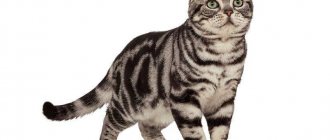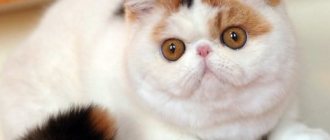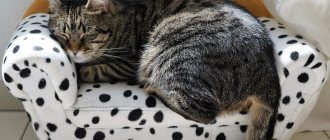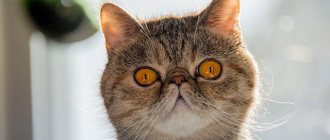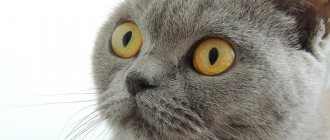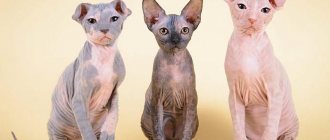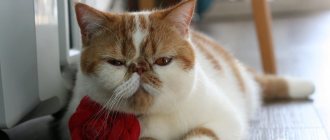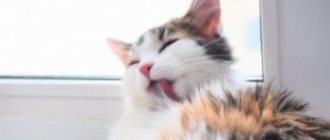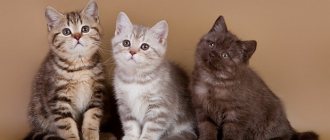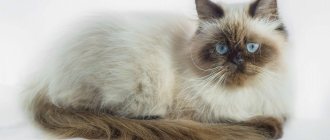Description of the German Rex breed
Popularity 72nd among 87 cat breeds
Lifespan:
12-16 years old
Height:
23-27 cm
Country of origin:
Germany
Average price:
70 thousand rubles
Weight:
3-5 kg
Latest articles Cat health
Ataxia in cats: what is it, how does it manifest and is treated 01/23/2022 156 0 0
Cat health
Leukemia, or viral leukemia in cats 01/23/2022 145 0 0
Relationships with people and animals
They love children and are always happy to play with them, but they can stand up for themselves. If a child hurts a cat, the latter will definitely let him know what he shouldn’t do, he will swing or snort, and if there is no reaction, he may even give in with his paw. Therefore, immediately explain to children that a cat is not a toy, but a living creature, and should be treated accordingly.
The German Rex gets along well with other pets only if it has grown up with them since childhood. In other cases, the process of addiction is long and difficult, even leading to fights and aggressive behavior.
Key facts
The German Rex (or Prussian Rex) breed can be safely acquired if there are small children in the family. These are sociable, friendly and patient pets with very soft and pleasant to the touch fur.
Their genes contain a love of hunting, so cats are active, mischievous, but at the same time loving affection and attention - they are always in a great mood, you definitely won’t get bored with them.
Description of the German Rex breed combines German neatness and Russian friendliness, as well as resigned obedience. Patience that turns into endurance and calmness that borders on laziness are the main character traits of the exotic breed.
At the same time, Germans are incredibly responsive and gentle, resourceful and quick-witted, readily involved in any household activity and stick their little nose everywhere. These are incredibly clean animals, capable of keeping the house clean and even tidying up toys, thereby demonstrating affection and extraordinary abilities to their owner.
Here is a brief description of the German Rex breed:
- Country of origin: East Prussia, early 20th century. Mom is a Russian Blue, dad is an Angora cat.
- Character traits - an active, playful, restless cat who will always find something interesting to do in the house. He loves attention and communication, and tries to tell something with his pleasant, insinuating purring.
- Gets along well with dogs and other pets.
- Animals do not need special care, but in winter the cat must be protected from drafts - wool without undercoat is not able to warm the body at low temperatures.
- For the same reason, in winter, the volume of food portions should be increased, which will give the cat more energy for heating.
- With proper maintenance, the life expectancy of the German Rex reaches 17 years. On average, cats live about 15 years.
The Prussian Rex is an “indicator” of mood, he has a great sense of his friend-breeder, and is always ready to support and console him. The animal is even able to relieve headaches: it lies down next to its owner and purrs. If the owner is offended, the cat can defend himself like a real dog.
Description of standard appearance and color options
The animal's fur feels like velvet to the touch. It lies on the body in flowing waves, while being extremely dense and of medium length. The tail is neat, but looks a little plain due to the bald spots all over the surface.
The paws are graceful and elegant, but the hind legs are longer than the front ones. The body itself is well developed, the cats are muscular, and the body is rectangular in shape. The chest is wide and rounded. Representatives of this breed have an unusual property that is associated with eye color. Their shade must be combined with the color. Their ears are small, evenly and widely spaced.
The nose has a small depression that is almost impossible to notice. The head is round in shape with clearly defined cheekbones and a powerful chin.
When evaluating a German Rex, they first of all pay attention to the structure of the coat, its waviness and color.
Only registered animal colors are recognized. Maybe in the following colors:
- black;
- white;
- ginger.
History of the origin of the German Rex
The first mention of the German Rex dates back to the 30s of the 20th century. The first representative of the elite breed was the cat Munch, born from a Russian blue cat and a Persian. The animal was covered with wavy and short hair, the cause of which was a gene mutation.
Munch came to the Schneiders, who lived in the city of Konigsberg (Germany). Hence the name of the breed - well, “Rex” in translation means “curly”. The kittens born from Munch attracted the attention of breeders all over the world with their unusualness.
Selection continued: in the 60s of the last century, the German Rex was crossed with European, American shorthair breeds, Cornish Rex, and curly-haired cats with a velvety and soft coat without undercoat were bred.
In 1970, German Rex cats were recognized by WCF and FIFe as a new and natural breed with its own standards. Today, animals take an active part in international exhibitions and are as popular as the Devon, Selkirk and Ural Rex.
Historical reference
Most good things happen spontaneously, and the same can be said about the origin of the German rex. The cat that gave birth to the first “curly hair” lived in an unremarkable family and was “spontaneously” mated with a cat of the Russian blue breed, imported from the German Empire. Geographically, events developed in the province of Prussia, not far from modern Kaliningrad. The owner liked the curly-haired kitten Munch not because of his fur type, but because of his intelligence. In addition, Munch turned out to be a very fertile male and became the father of kittens from many “village” cats.
The profession of a breeder did not exist in Imperial Germany, and indeed, it does not officially exist now. But there were people involved in the selection of livestock, dogs and cats, today they would be called binders. It is not known for what personal reasons the “Imperial Binder” ended up in the province of Prussia, but an event occurred - shortly after the birth of Munch’s next “batch of children,” curly-haired kittens were spotted. The nascent breed became the property of the city of Konigsberg. One of the wealthy cat connoisseurs managed to buy a curly-haired baby from a nursery and went with him to Berlin, this became the “starting point” for the spread of the breed in Germany.
During the occupation of Germany, soldiers and refugees leaving the country exported animals en masse, including Hermann Rex cats. In 1951, a curly-haired cat fell into the hands of physician Rose Carper. The breeder named the pet Lamb and decided to find out what caused the birth of a cat with curly hair. Lamb died in 1964, and in 1968 the vom Grund nursery gathered all the heirs of the curly-haired cat within its walls and began professional work
The German Rex cat became a sensation and attracted the attention of all clubs and communities of cat lovers in Europe, and later, throughout the world
The champion breed standard was adopted in the 70s; oddly enough, almost all clubs immediately recognized the German Rex as a separate breed. “Curlytails” can hardly be called an exclusive pet; Hermann rexes are widespread in the world. At every international exhibition you will probably meet a German Rex, however, the opportunity to purchase kittens is limited due to the small number of clubs in Russia and the fairly substantial price.
What does a German Rex look like?
These are well-built cats with a proportional body, strong, large and well-developed limbs, a medium-length cone-shaped tail and a tucked belly. Wool comes in different colors, but is not monochromatic. Its density varies from a thin soft cover to a uniform dense structure, the hairs are easily curled by nature.
Muzzle
As you can see in the photo, the German Rex has a voluminous rounded head, and on it there are widely spaced ears that taper upward, have rounded tips and a strong edge on the outside.
The nose is slightly flattened, which, together with the gaze of wide-open almond, blue or yellow eyes, gives the cat a special cuteness. The cheeks are distinct, the vibrissae are short and curled.
Body type
The bones are quite large, the back is strong, the chest is rounded in profile, the body is medium-sized with well-developed muscles. The legs are thin, slender, with compact and oval pads.
The forelimbs are slightly smaller than the hind limbs. The tail is covered with abundant fur and tapers towards the end.
The marriage of an elite breed is considered:
- twisted skeleton;
- ears too small;
- pointed head;
- lack of fur in certain areas;
- incorrect teeth bite.
Animals that are too large are also rejected - the German must be graceful.
Coat and color
The German's coat is short, soft to the touch, without guard hairs and has curls that can run chaotically or in clear rows. Vibrissae on the eyebrows, just like a mustache, are curly.
The varieties of the German Rex breed are quite diverse in terms of coat color: red, black, ash or completely white cats - the combination of tones can be any.
When assessing, first of all, attention is paid not to the color of the German Rex, but to the condition of the coat - strong waviness, first of all! The highest points are given to animals with the best curly hair, even if they are inferior in body type to the rest of the exhibitors.
Poodlecat
This breed of cat in Germany is called "Pudlekatze". The Poodlecat has not received recognition in any international or national cat federation. Even in Germany, the competent authorities do not approve its standard. In Germany, cats with folded ears are not recognized, therefore, the poodle cat is not yet deprived of such a privilege.
Origin story
In 1987, in Starnberg, Dr. Rosemary Wolf, a German breeder of Scottish Fold cats, decided to conduct an experiment to create a new variety of the Rex breed. The Poodlecat shares DNA with Devon Rex, Scottish Fold and European Longhair cats.
The next step was to use Manx to breed a tailless variant , but most breeders were adamantly opposed to mixing two genes that cause skeletal defects.
German law prohibits the breeding of cats with certain physical abnormalities in cats. For this reason, the poodlecat breeding program in Germany was curtailed, but interest in them remains in other European countries.
Appearance and color
Distinguishing features of Poodlecats include folded ears and a stockier body than the Devon Rex. The wool is thick, dense and curly, reminiscent of sheep's wool.
The Poodlecat is one of the rarest cat breeds in the world. Consider yourself lucky if one of these uniquely beautiful cats comes into your life!
Character of the German Rex breed
Prussian cats are very sweet and friendly, completely devoid of aggression. They are incredibly patient and kind - they will never hurt a small child and get along well with other pets.
Rexes do not choose a leader for themselves, treating all family members well. Animals love affection and attention, quickly become attached to humans, and demonstrate their devotion and love through their voices and actions. The German Rex subtly senses the mood of people and tries to adapt to them. When the owner is in a good mood, the cat is cheerful and playful, and if the owner is sad, the animal will become quiet, sit next to him or climb onto his lap for “communication.”
The Prussian Rex loves attention. He is naturally energetic, incredibly curious and smart. Loves to play with toys, carry and hide them in secluded places. Even a castrated animal remains active and mischievous until old age.
Cats radiate positivity and lift the spirits of those around them. Even when household members do not have free time to play, the cat will always find something to do to his liking.
German rexes quickly get accustomed to unfamiliar surroundings: they explore everything and always. It is unlikely that there will be a place in the apartment where the cat does not get into: packages, boxes, bags, houses, balls are the best entertainment for them.
Despite their apparent calmness and peacefulness, the Germans are very wary of guests and hide in a secluded place when they arrive. It is quite possible that as time passes, the cat will come out of hiding to sniff strangers and even get to know each other.
In general, the character of the German Rex is very tactful and obedient. They prefer a measured and calm lifestyle, so many individuals do not tolerate moving and participating in exhibitions well.
Table: pros and cons of the breed
| pros | Minuses |
| Attractive appearance | Rarity of the breed in our country |
| High intelligence and obedience | Talkativeness and playfulness can sometimes be excessive |
| Loyalty and love for the owner and his family members | Intolerance to change |
| Cleanliness and neatness | Intolerance of loneliness |
| Ease of care | Love for owners borders on obsession |
| Good health and strong immunity | Possible hair problems (baldness) |
| Affordable price of kittens | Excessive curiosity and entrepreneurship |
Thus, the German Rex can be safely called an ideal pet for families with children, because it is one of the best companions: playful, with an active lifestyle and completely non-aggressive. In terms of devotion and love for the owner, representatives of this breed have no equal, and they are also clean, smart and obedient, unpretentious in matters of nutrition and grooming. The only problem is to find such a kitten in Russia. It is easier to purchase it in another country - Germany or Holland.
Raising German Rex
In the world of whiskers, Prussian cats enjoy the reputation of true intellectuals: it is very easy to instill in them the necessary qualities of behavior. Curly-haired animals are easy to train, go to the litter box, do not damage furniture, carpets and wallpaper, and do not mark their territory. Training should begin at an early age, as soon as a small playful kitten gets into the house.
It is necessary to immediately show who is the owner, what can and cannot be done, and follow clear rules for the rest of the animal’s life. There is no need to strictly punish the Prussian Rex - to reprimand it is enough to raise your voice a little. There is no need to hit or drag the animal by the scruff of the neck, otherwise in the eyes of the pet you will become a threat that he will want to avoid.
Curly-haired cats are good at distinguishing the tone of commands, so raising German Rexes does not cause any particular difficulties. A little patience, love and affection - and you can teach your cat standard “dog” commands: “lie down”, “sit”, “give me a paw”, “bring a toy or ball”.
Cats enjoy walks in the fresh air and easily get used to the collar. They quickly understand the purpose of the scratching post and the tray with the filler, so there will definitely be no problems with maintaining hygiene in the apartment or house.
Character and behavior
Rex has an extraordinary character; he gets used to people in a short time. Becomes a true friend, especially for those who experience loneliness. Animals have well-developed intelligence, so they recognize the mood of those around them. They love to play with toys; if they are satisfied with their habitat, they will definitely inform their owner about this.
They have a need to be the center of attention, even if there are strangers in the house. They treat children quite well, play with them, provided that no one hurts the cat.
The German Rex cat has an easy-going character and does not show aggression. Sometimes you can see purring for no reason, and this means that the pet is in the mood and is ready to “chat” with a person about his cat life.
They sleep in their own separate place. You should not train them to sleep in a bed, as they shed and the bedding will quickly become filled with animal hair.
They cannot tolerate separation from their owner and experience stress when separated. The same can be said about changing housing. They need stability
The cat does not get along with other animals and can be aggressive and fight. This is how jealousy manifests itself. If she lives with him from birth, then she can exist quite peacefully.
German Rex Health
Germans enjoy good health and rarely suffer from genetic diseases. On average, cats live 14 years, but with quality nutrition and proper care, the lifespan can increase to 18 years.
Get your vaccinations on time, visit the veterinarian regularly, and then the health of your German Rex will not cause any concern throughout its life.
Possible diseases
German Curlies rarely have congenital problems, but it is still worth making sure the kitten is healthy by asking the nursery for a certificate. Serious pathologies are:
- Hypertrophic cardiomyopathy
– thickening of the walls of the heart ventricle, which reduces the volume of pumped blood. This leads to a disruption in the rhythm and frequency of contractions. At the initial stage, symptoms appear extremely rarely, but the disease is very insidious and can lead to death.
- Coagulopathy
– lack of vitamin K in the body, which leads to poor blood clotting: the cat can die from its rapid loss due to injury.
The German Rex is susceptible to infectious diseases and can pick up lichen, fleas, and ticks. To prevent your pet, you need to bathe it once a week with a special shampoo, and then apply parasite-repellent products to its coat. Once every 3-4 months, rexes should be given deworming tablets.
Reproductive health
If the destiny of the Prussian Rex is to please people with its unusual beauty and devotion, and not to take part in exhibitions and increase the population, then it is better to castrate it. This is allowed to be done no earlier than 8 months of age, when the animal’s reproductive organs are fully formed. The operation is performed in a veterinary clinic.
A German Rex cat's first heat appears at about 7 months of age. You should not breed her right away: it is better to wait another 5-6 months, when the reproductive system is fully formed and the animal can produce healthy offspring.
Particular attention should be paid to choosing a gentleman. He must be purebred, without genetic diseases. It is advisable to mate an inexperienced cat with an experienced male.
Preliminary preparation is also important - expectant parents need to undergo anthelmintic prophylaxis, trim their claws and bathe them in anti-flea shampoo. In order for the cat to get used to unfamiliar territory, she is brought to the cat a few days before mating with a bowl for food and water, a bed, a tray, and her favorite toys.
Typically coverage occurs within the first 24 hours. Pregnancy appears on the 14th day and lasts up to 63 days. 7 days before giving birth, the female becomes restless, she carefully licks her fur coat and looks for a place, preparing for delivery.
Kittens are left with their mother until they are 2 months old: all this time they feed on their mother’s milk, acquire immunity and basic independent living skills.
Castration and sterilization
If the owner does not have serious plans to breed German Rexes, then it is better to castrate the pet. Despite the fact that their sexual temperament is not as pronounced as in other breeds, inappropriate behavior of the pet most likely cannot be avoided. In addition, an animal whose regular hormonal surges are eliminated and sexual instincts are muted becomes more stress-resistant and intelligent, and it is easier for it to fully express its intelligence and wonderful character.
At what age is it recommended to do it?
The optimal age for castration of a pet is 7–9 months. It is advisable to have the operation performed on your cat before her first heat. Castration can be done at home or in a clinic. The cost of the procedure ranges from 1 to 3 thousand rubles. Thanks to modern advances in medicine, the operation is carried out quickly and does not pose a threat to the health of the pet. Within a week after the intervention, the cat’s activity and normal behavior are fully restored.
Caring for your pet after surgery
After the operation, you need to monitor how the animal recovers from anesthesia and whether it feels well. It is better not to feed your pet on this day, so as not to cause vomiting, but you can and should give it something to drink. If the cat is cold, which often happens when recovering from anesthesia, then you need to wrap it up and warm it up or organize a warm place near heating devices.
The seams will have to be lubricated with a product recommended by the veterinarian for several days. Regular greenery will also work. If your pet persistently licks the suture area, you will need to put a special post-operative collar (Elizabethan) on him for a couple of days.
In an Elizabethan collar, a cat can eat, drink and sleep, but cannot bite or lick its body.
Features of feeding and diet
German Rexes have an excellent appetite and will eat anything. The ideal solution is to feed animals natural food, adding the following products to the daily diet:
- yogurt, sour cream, low-fat cottage cheese;
- boiled and raw beef, chicken;
- sea fish without bones;
- offal;
- boiled vegetables;
- cereal porridge;
- fresh eggs.
It is not recommended to feed your omnivorous pet greens, berries and some fruits, especially sour ones. It is not recommended to give your German Rex:
- sausages, sausages;
- skin, bones;
- smoked, fried, spicy foods;
- all flour, sweets.
Since animals are prone to obesity, they need to be fed rationed. Small kittens require frequent feeding - up to 5 times a day, “teenagers” - 3 times a day, adult cats - up to 2 times.
The serving size will determine the pet's weight. The optimal rate is calculated using the formula: the weight of the animal is multiplied by 5%. So, a 4-kilogram cat should be given no more than 200 grams of food per day.
The weight of dry food should be half as much, since it is supplemented with water and swells in the stomach. A table with standards is usually printed on the packaging. Dry food is an excellent choice if you don’t have time to cook or are afraid of creating a natural menu incorrectly.
Possible problems
The German Rex is prone to overeating, which leads to rapid weight gain and obesity. Therefore, the owner must carefully monitor the diet, try to feed several times a day and at the same time. Then gradually the animal will get used to eating at certain hours and will stop begging for food.
Severe depression may occur if your pet is left without proper attention. Rexes love to be the center of everyone's attention; if you forget about this, they become blue and stop playing and “talking.” Reviews from owners indicate that they become attached to people.
Care and maintenance
The German Rex has no undercoat in its coat, which makes everyday care much easier. Combing is not done often - once every 4-5 days. Bathe your Rex in room temperature water with cat shampoo once every 3-4 weeks. After washing, the short coat is thoroughly dried and any drafts are avoided.
The eyes are wiped with a cotton pad soaked in black tea or a special lotion, and the ears are cleaned with the same. The claws are trimmed once every two weeks with a nail clipper, and the sharp parts of the cat are sharpened themselves. To prevent damage to furniture, carpets, curtains and wallpaper, there must be a scratching post in the house!
In the care and maintenance of the German Rex, special attention should be paid to nutrition. Cats are omnivores and love to eat, which is why they are often obese. To prevent this from happening, food should be rationed, and active games and walks in the fresh air should become a favorite activity for the pet.
During molting, you need to increase the amount of vitamin B in your food, which will prevent the appearance of unsightly bald patches on the skin. It is recommended to give the animal food with grass and special means for removing hair from the stomach. Lost hairs should be combed out every day and carefully collected from pieces of furniture with a vacuum cleaner or a damp glove.
Owner reviews
Irina, 33 years old:
“I got my baby in Europe. I spent quite a lot of money, but I don’t regret it at all. The cat has become a full-fledged member of the family.”
Anatoly, 49 years old:
“Rex is different from all the felines I know. He loves to play with children and does not show any aggressive qualities.”
Mikhail, 45 years old:
“My wife is a cat lover, and I decided to surprise her by finding an unusual cat with wavy fur. He looked very much like a little sheep. The gift was to the liking of the beloved woman. Now she treats him like a child.”
Valentina, 28 years old:
"It does not require special care. I like that it practically does not shed. He walks with me everywhere, like a tail. Loves to be petted."
Antonina, 62 years old:
“I live alone, and so that it wouldn’t be boring, my grandchildren gave me a kitten. Playful, I talk to him a lot. I made a small corner for him where there are his toys and a scratching post.”
Nikolay, 50 years old:
“I’m just delighted with my cat, she’s energetic and positive. When guests come, she always tries to be the center of attention.”
Tips for choosing a kitten
It is quite difficult to buy a German Rex in the Russian Federation. Most likely, for show-class animals you will have to turn to European breeders and pay a lot of money. Certain difficulties will arise with transporting the animal to its future owner.
The breed is very similar to the Devon Rex, but there are differences. An elongated and rounded head, wide and large ears with very soft fluff on the back, wide open and round eyes that harmonize with the color will help to distinguish a German Rex kitten from similar breeds with curly hair.
No less attention should be paid to the purity of the pedigree - for this, breeders present metrics and certificates. The animal's father and mother must be completely healthy, and the kitten must be active, cheerful, moderately well-fed, with clean eyes and ears, a beautiful wavy coat and fully vaccinated, which should be reflected in the veterinary passport.
If you are a beginner breeder, when choosing a German Rex kitten, seek help from a professional nursery specialist. He will help you choose a purebred baby and give you tips on completing the paperwork.
Buying a kitten
It is difficult to buy a German Rex kitten in Russia. If this is unimportant, it is better to choose a Cornish Rex or Devon Rex. There are many nurseries that breed cats of these breeds.
However, if you want a “German”, you will have to negotiate with European breeders. It will cost from 15 to 50 thousand rubles. Also, certain difficulties may arise when transporting an animal.
It is very difficult to distinguish a German Rex kitten from a Devon Rex. Both breeds have a rounded, short head, but the Devons have a heart-shaped head, while the Germans have a slightly more elongated head. The ears of both breeds are large and wide. There are differences in the quality of wool: Devons have hard guard hairs, while Germans do not, so it is very soft. However, the coat (like the waves) is finally formed only by 1 - 1.5 years, and in kittens the fur can be completely straight or even fall out completely. The differences between them are so minimal that the authoritative organization CFA, as already mentioned, considers them to be the same breed.
Cornish Rex dogs are quite easy to recognize: they have an elongated muzzle and a wedge-shaped head. There are also differences in the shape of the ears: they are narrower and more elongated. Cornish Rex eyes are almond-shaped rather than round.
How much does a German Rex cost?
The rarity of cats explains their high cost. The price of a German Rex reaches 70 thousand rubles, it depends on the purity of the pedigree and class:
- pet
– animals cannot participate in exhibitions, qualify for awards, are not bred for the purpose of further sale, but are usually purchased as a pet;
- breed
– cats meet the standards of an elite breed, but do not have any special qualities in appearance to win at exhibitions; they can produce show-class kittens when crossed with an excellent male;
- show
– kittens are very expensive, their purebred parents have titles received at exhibitions; Such animals are capable of bringing good profits to their breeder.
The cost of the kitten will have to include a trip abroad and transportation of the animal itself. But all the efforts will pay off - after all, the German Rex is capable of becoming a true family friend, giving warmth and affection to the people who love him.
Do you like the article? 0
How to breed
If the owner’s plans do not include breeding Rex, then it is better to carry out a sterilization or castration procedure. Reproductive functions are fully formed at 1 year. At this age, the cat is ready for offspring and is able to reproduce healthy kittens. The first heat occurs at 8 months, but breeders do not recommend mating at this age. You must wait until you reach full puberty.
It is better if the partner already has experience, then the breeding process will be much easier. Before mating, you need to get vaccinated, it is carried out 15 days before the selected date. All preventive measures are also taken to remove parasites from the body.
A cat bears offspring for 60-65 days. The birth process is quite simple and practically does not require any human intervention.
Catering
The special structure of the kidneys allows cats to drink less than humans. But their drinking water should also be clean and fresh. You should not pour water from the tap - it contains many undesirable elements that are safe for humans, but dangerous for animals. Therefore, use special filters to purify moisture or leave it in an open jar for at least 12 hours. You can also buy bottled water.
Natural products
The food on your table is not suitable for cats. This is very taboo for her. Sweet, salty, pickled, smoked, fried, baked, starchy, people with spices and sauces - the list is long! Products containing cocoa beans do not decompose in the animal’s body, but accumulate in the liver and lead to poisoning.
The same goes for beer and other alcoholic drinks. Tea (both black and green) causes disorders of the cardiovascular system, potatoes and tomatoes - the gastrointestinal tract, onions and garlic cause anemia, avocados, grapes, raisins and eggplants - vomiting and diarrhea, boiled bones can injure the intestines, perforate his.
Some foods are not prohibited, but are undesirable. These are legumes (in the process of fermentation), seeds, pasta, baked goods, condensed milk, pork, sea fish, whole cow's milk, chicken protein, raw eggs, goose and duck meat, raw liver, dog food and vitamins for humans.
The diet should include:
- Fresh meat: beef, rabbit, veal, turkey and lamb. It is cut into small pieces (only infants and toothless animals are allowed to grind minced meat) and blanched with boiling water.
- Chicken and beef by-products: kidneys, liver, heart. They are boiled or stewed.
- Sea fish: hake, trout, salmon, halibut. Boiled shrimp and squid can be served once a week. Don't feed fish more than once a week, otherwise your cat will develop kidney problems as she ages.
- Fermented milk products: cheese (hard unsalted variety), kefir, yogurt, fermented baked milk, cottage cheese. Natural yogurt is also allowed, which does not contain chemical preservatives, flavor enhancers or dyes.
- Vegetable oil: olive, sunflower, flaxseed, butter. Add half a teaspoon to the porridge every day.
- Boiled chicken protein, quail eggs.
- Porridge cooked in water: rice, corn, millet, buckwheat, oatmeal, millet. You can also add vegetables: green beans, cauliflower, carrots, zucchini, zucchini, greens (spinach, dill, parsley, green salad).
- It is allowed to give cats apples, melons, pears, and corn as gifts.
Vitamin complexes are also good. Choose quality multivitamins and supplements that contain phosphorus, calcium and other beneficial microelements.
Recommended food
From ready-made food, both breeders and veterinarians recommend giving animals food of a holistic class: Acana, Farmina N&D, Wildcat. For their production, good quality products are used, and the composition speaks for itself: a sufficient amount of meat, dried fish, berries and vegetables, vitamin and mineral supplements, natural preservatives are acceptable.
Cheap and premium feeds have the only advantage - low price. The composition raises many questions. Firstly, the packaging does not indicate specific meat, but “meat waste”. What is behind this verdict is unknown. Plant-derived ingredients, especially corn gluten, often cause allergic reactions. It contains very few vitamins and minerals, but there are enough artificial dyes and preservatives that have an extremely negative effect on the health of animals.
Below are recommended complete foods and super premium foods. Links with food names are clickable; you can use them on our website to view food descriptions and read reviews from owners of German Rex cats.
| Holistic | Super premium | Super premium |
| Primordial | Superpet | Organix |
Feeding the cat
To maintain activity, German Rex cats need a balanced diet. And to compensate for heat loss, the menu of cats of this breed should contain a sufficient amount of fat.
To save time, your German Rex can be given ready-made food. When choosing drying, it is advisable to give preference to premium or super premium products. It has a balanced composition and contains all the necessary vitamins and minerals. The following brands of food best meet these requirements:
- Arden Grange;
- Hills;
- Pronature;
- Brit Care.
With a natural type of nutrition, the diet of the German Rex is designed so that fresh meat predominates in it. The cat is also given porridge, vegetables, fermented milk, eggs, ocean fish and offal.
To keep your German Rex healthy longer, it should not be fed pork, sweets, baked goods, sausages or beans. Also, the cat is prohibited from giving river fish, bones, whole milk, starchy vegetables, exotic fruits and any food from the owner’s table.
Vaccinations and antiparasitic treatment
To prevent viral and infectious diseases, German rex dogs are systematically subjected to routine vaccination. At the age of 7-8 weeks, a German kitten is vaccinated with a complex drug that stimulates the development of immunity to panleukopenia, rhinotracheitis and calcivirosis.
After 28 days he is vaccinated against the same diseases and against rabies. In the future, German Rex is vaccinated annually.
To prevent the development of diseases carried by parasites, the cat is periodically treated for fleas and helminths. Antihelminthic drugs are given to German Rex twice a year with mandatory repetition after 10-14 days. The dosage is selected strictly according to the weight of the German cat.
To combat fleas, use special drops or shampoos. And if the German Rex is outside, he is put on an anti-parasitic collar.
